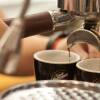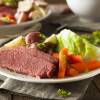If I’m being honest, a lot of cocktail trends make me roll my eyes and order a beer. But the appearance of shrubs on cocktail lists in Boston has been a refreshing revelation. All but extinct until 2004, the shrub was a relic of colonial America, favored by the Pennsylvania Dutch and nobody else. Then food columnist Eric Felton ran a story on Tait Farm Foods in Pennsylvania and their commercially available drinking vinegars called shrubs. The curious combination of fruit, sugar and vinegar slowly caught the attention of bartenders and many adopted it as an alternative method for incorporating acid in drinks.
Shrubs are being put to good use at Alden & Harlow in Harvard Square, where I met with bar manager Seth Freidus. “Shrubs are a great cocktail component,” Freidus says. “When you a have rich, sweet fruit flavor, and cut it with vinegar, it adds so many different layers of flavor from just one ingredient.”
The single ingredient concept has huge appeal to Freidus, who can pack a ton of flavor into a lone component. For instance, he makes a rhubarb shrub from cold macerating (that just means mixing stuff with sugar) rhubarb, shishito peppers, and pink peppercorn, before adding vinegar to create an entire system of flavors that can be added in small proportions.

Currently on the menu is the Liguria fizz ($12) which contains the aforementioned shrub, gin, Santa Maria (the Ligurian amaro also contains rhubarb), lemon, agave, egg whites, and tonic water, creating a high acid and creamy cocktail that’s bright and tart without making you wince. It’s super refreshing and dangerously crushable.
Shrubs have been around in one form or another for centuries, but they're a dificult thing to define. Depending on what time period you're looking at, the shrub takes many forms. To help clear up the confusion, I reached out to food writer Michael Dietsch, who happens to be the author of Shrubs: An Old Fashioned Drink for Modern Times .
“Today, everyone uses the term to refer to a drinking vinegar. To avoid confusion, I’d say it needs to be a beverage with a fruit or vegetable base, mixed with sugar and vinegar,” Dietsch explains. “But when looking at shrubs through time, the definition gets tricky.
“Historically, it was all over the map,” he says. “Originally, it meant a beverage made of dried citrus, sugar, and herbs or spices. This would be reconstituted with water and served to non-drinking Muslims. Later, this same beverage was used to smooth out the rough edges of early rums and brandies. Both products, boozy and non, took the name shrub. Still later, the term was adopted to describe a mix of vinegar, sugar, and fruit, as it is today.”
The shrubs we know were a popular treat in Colonial America, and a useful tool for preserving fruit through the colder months. Often used as a tart and refreshing non-alcoholic beverage, shrubs were a hit with abolitionists and stuck around through prohibition until refrigerators made old fashioned preservation obsolete, and sweet sodas like Coca Cola stole the hearts and pallets of young Americans.
Dietsch thinks shrubs have returned because, “they provide acidity to a cocktail in the same way citrus juice does, but additionally provide a depth of flavor that citrus doesn’t. They’ve helped bartenders expand their tool kit.”

Over at Commonwealth Cambridge in Kendal Square, bar manager Bryant Peng uses Bittermans Hellfire Habanero Shrub in his fire bird cocktail ($11). If Freidus likes the shrub’s efficiency, the Hellfire Shrub takes things to a whole new level. Somewhere between a shrub, bitter and a hot sauce, it requires only a few drops for maximum effect. Peng uses the product sparingly in the fire bird, a paloma variation made with tequila, mezcal, jalapeno syrup, lime, grapefruit, and soda.
“The shrub added heat, bringing it to the forefront,” Peng says. “We don’t want it to be overbearing. It’s not a hot wing contest. It’s present and noticeable without destroying the flavors of the drink.”
Peng’s right. It’s a nicely built cocktail with layers of spice that unfold in your mouth without burning out your pallet.
Shrubs are relatively new to Peng but he has big plans for the summer, which include a house made peach and basil shrub intended for multiple uses. “The nice thing with shrubs is that you can make an awesome cocktail and then for your non drinkers you can add some soda water to it and still create something with a lot of really deep flavors.”

The non-alcoholic aspect of shrubs is a nice benefit. Kate Broughton is the owner of Spiker's Shrubs in Amesbury. Her interest in shrubs began when she was taking a break from drinking and found that soda water with lime didn’t feel festive enough for social functions and special occasions. Stumbling upon shrub recipes on a website for historical Williamsburg, Broughton began experimenting with concoctions of her own. After prodding from friends, she began bottling her shrubs in the spring of 2014.
Broughton is very serious about her methods. She says the secret to making a great shrub is cold maceration and ageing. Whole fruit sits in sugar until the juices are drawn out and then she adds vinegar and ages the product anywhere from two to four weeks.
“I’ve tried every method and nothing comes close to the cold ageing process,” she says. “That’s what we do. It’s slow and we make small batches at a time. But we’ve had a pretty good response.”
While Broughton loves the non-alcoholic applications of shrubs, she also likes what they do for a spirit., “Shrubs let the spirit of the spirit shine through giving it an extra dimension. Put a little splash into a cup of Irish whiskey and it comes alive.”
Alden & Harlow
– 40 Brattle St., Cambridge, 617-864-2100, aldenharlow.com
Commonwealth Cambridge
- 11 Broad Canal Way, Cambridge, 617-945-7030, commonwealthcambridge.com
The Boston Shaker
– 69 Holland St., Somerville, 617-718-2999, thebostonshaker.com
Looking to make a shrub of your own? Check out our recipe for
Blackberry Balsamic shrub here
.




